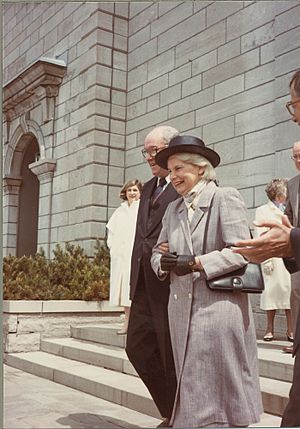Jeanne Sauvé facts for kids
Quick facts for kids
Jeanne Sauvé
|
|
|---|---|
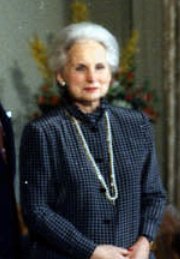 |
|
| 23rd Governor General of Canada | |
| In office May 14, 1984 – January 28, 1990 |
|
| Monarch | Elizabeth II |
| Prime Minister | |
| Preceded by | Edward Schreyer |
| Succeeded by | Ray Hnatyshyn |
| 29th Speaker of the House of Commons of Canada | |
| In office April 14, 1980 – January 15, 1984 |
|
| Monarch | Elizabeth II |
| Governor General | Edward Schreyer |
| Prime Minister | Pierre Trudeau |
| Preceded by | James Jerome |
| Succeeded by | Lloyd Francis |
| More... | |
| Personal details | |
| Born |
Jeanne Mathilde Benoît
April 26, 1922 Prud'homme, Saskatchewan, Canada |
| Died | January 26, 1993 (aged 70) Montreal, Quebec, Canada |
| Political party | Liberal |
| Spouse | Maurice Sauvé |
| Profession | Politician, journalist |
| Signature | |
Jeanne Mathilde Sauvé (born Benoît; April 26, 1922 – January 26, 1993) was a Canadian journalist and politician. She made history as the 23rd Governor General of Canada, serving from 1984 to 1990. She was the first woman to hold this important role.
Born in Prud'homme, Saskatchewan, Jeanne Sauvé studied in Ottawa and Paris. She began her career as a journalist for the Canadian Broadcasting Corporation (CBC). Later, she entered politics and was elected to the House of Commons in 1972. She served as a government minister until 1980, when she became the Speaker of the House of Commons.
In 1984, Queen Elizabeth II appointed her as Governor General, following the advice of Prime Minister of Canada Pierre Trudeau. She took over from Edward Schreyer and served until Ray Hnatyshyn replaced her in 1990. While her appointment was generally welcomed, some people had concerns about increased security around her office.
Jeanne Sauvé was sworn into the Queen's Privy Council for Canada in 1972. After her time as Governor General, she founded the Sauvé Foundation. She passed away on January 26, 1993, due to Hodgkin's lymphoma. The top award for the Canadian Ringette Championships, a major national sports event, is named the Jeanne Sauvé Memorial Cup in her honour.
Contents
Jeanne Sauvé's Early Life and Career
Jeanne Sauvé was born in Prud'homme, Saskatchewan, a French-speaking community. When she was three, her family moved to Ottawa. Her father often took her to Parliament Hill to see the statue of Agnes Macphail, Canada's first female Member of Parliament.
Sauvé studied at Notre Dame du Rosaire Convent in Ottawa. She was a top student. To pay for her studies at the University of Ottawa, she worked as a translator for the government of Canada. She was very active in student and political groups. At 20, she became the national president of the Young Catholic Students Group. This job led her to move to Montreal in 1942.
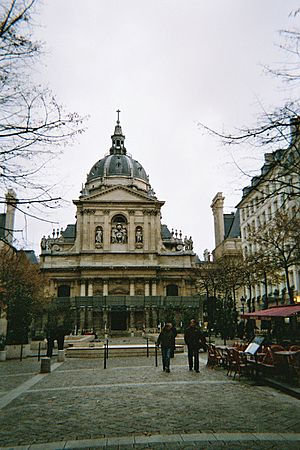
In Montreal, she met Maurice Sauvé. They married in 1948 and moved to London, England. Maurice had a scholarship to the London School of Economics, and Jeanne worked as a teacher. Two years later, they moved to Paris. There, Jeanne worked for UNESCO and studied at the Sorbonne. She earned a degree in French civilization in 1951.
The Sauvés returned to Canada in late 1952 and settled in Saint-Hyacinthe, Quebec. Their son, Jean-François, was born in 1959. Jeanne became a founding member of the Institute of Political Research. She then started working as a journalist and broadcaster for the Canadian Broadcasting Corporation (CBC), especially for its French-language service, Radio-Canada.
Her first radio show, Fémina, was very successful. She then moved to CBC television, covering political topics in both English and French. She became well-known and often appeared on the show Les Idées en Marche, where she shared her left-wing political views. It was unusual for a woman to be a political journalist then, but Sauvé was taken seriously. She even got her own TV show, Opinions, which discussed important topics like parental authority. This show, on air from 1956 to 1963, made her famous.
Some people questioned her role when her husband became a government minister. A Member of Parliament from the Progressive Conservative Party of Canada wondered if it was right for the wife of a minister to be paid by the CBC.
Jeanne Sauvé's Political Journey
The Liberal Party of Canada asked Jeanne Sauvé to run for election in Montreal in 1972. She found campaigning difficult, but she won, becoming one of only five women elected as Members of Parliament (MPs).
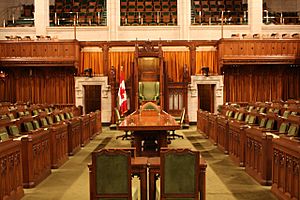
After her election, she joined the Queen's Privy Council for Canada and became the Minister of State for Science and Technology. This made her the first woman from Quebec to become a government minister. She was the only woman in the Cabinet at that time. She won re-election in 1974 and became the Minister of the Environment, and then the Minister of Communications in 1975.
In the 1979 election, she won her riding again, but the Liberal Party lost power. She lost her Cabinet job. However, in the 1980 election, the Liberals won again, and Pierre Trudeau became Prime Minister. Trudeau chose Sauvé to be the Speaker of the House of Commons.
At first, Sauvé didn't want the job because she wanted to campaign against Quebec separating from Canada. But Trudeau convinced her she was the right person. She also got permission from all party leaders to speak out on the issue. She then became the first female Speaker of the House.
In her early days as Speaker, Sauvé sometimes made small mistakes, like mixing up MPs' names. Some MPs felt she favored the Liberal Party, and 32 New Democratic Party MPs even walked out in protest. Sauvé admitted that Liberals might have gotten more questions on some days, but overall, she tried to be fair. It was also thought that MPs were showing off for the new TV cameras in the House.
However, Sauvé was very successful in making the Speaker's office more professional. She improved how expenses and staff were managed. She cut down on unnecessary bureaucracy and saved $18 million in annual costs. Many people praised her for being brave and challenging the old ways. She also started the first daycare for Parliament Hill staff, MPs, and senators.
She also led important debates on the Constitution of Canada. She handled long delays and many procedural questions. She also dealt with a two-week protest by the opposition party. Despite pressure from the government, Sauvé insisted that the parties had to solve their disagreements themselves.
Canada's Governor General
Jeanne Sauvé became the first female Governor General in Canada's history. She was only the second woman in any Commonwealth realm to hold such a position.
Becoming Governor General
In December 1983, it was announced that Prime Minister Trudeau had suggested Jeanne Sauvé to Queen Elizabeth II as the next Governor General. Most people in Canada thought this was a good choice. They saw her elegance, refined manner, and ability to speak both English and French as great assets for the role.
Sauvé resigned as an MP and Speaker in January 1984. A few days later, she was hospitalized. There were rumours she had cancer, but the official reason was a respiratory virus. Even though she was ill, Queen Elizabeth II officially appointed her as Governor General on January 28, 1984. Sauvé's health was very poor, and some thought she might not recover. But she did get better and was released from the hospital in March. Her illness delayed her official installation ceremony. Sauvé kept the details of her illness private, saying it was her personal matter.
In Office
On May 14, 1984, Sauvé was sworn in as Governor General in the Senate chamber. Prime Minister Trudeau said it was right for the Queen to finally have a woman representative. Sauvé quickly announced that she would focus on issues important to young people, world peace, and national unity during her time in office.
The Governor General stayed informed about government matters and met with her prime ministers every two weeks. There were reports of some tension between Sauvé and Prime Minister Brian Mulroney. Some believed Sauvé did not like how Mulroney made his office seem more powerful, like a president. For example, he insisted on being the only one to greet American President Ronald Reagan during a visit to Quebec City. This was seen as a slight to Sauvé, who, as the Queen's representative, would normally welcome another head of state.
She did, however, welcome members of the royal family, including the Queen and Prince Philip, Duke of Edinburgh. She also greeted many foreign leaders, such as King Carl XVI Gustav of Sweden, Queen Beatrix of the Netherlands, and Pope John Paul II. Sauvé also traveled to other countries, representing the Queen in places like Italy, China, and France.
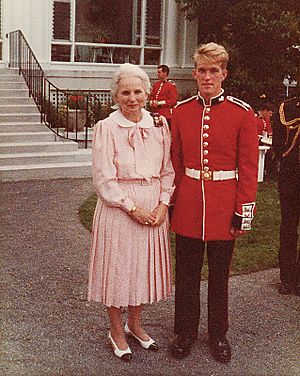
In 1986, Sauvé accepted the Nansen Medal on behalf of the "People of Canada." Two years later, she opened the 1988 Winter Olympics in Calgary. One of her favorite events was the annual Christmas party she hosted for the Ottawa Boys & Girls Club. Children came to Rideau Hall to visit Santa Claus and have lunch. Sauvé personally hosted and wore a paper party hat for the special occasion.
Some people criticized Sauvé for making her role seem too important. They said she acted like a president and even called her home "Republican Hall." For example, her staff interfered with a dinner hosted by the Lieutenant Governor of Saskatchewan. Also, event organizers were told not to sing the Royal Anthem or toast the Queen, but instead to toast Sauvé. This went against tradition.
In her final Christmas speech in 1989, some thought Sauvé was hinting about the failure of the Meech Lake Accord, a political agreement. This caused criticism because the Governor General is supposed to remain neutral in politics. Sauvé always maintained she was speaking about Canadian unity in general, not the specific agreement.
Jeanne Sauvé's Legacy
During her time as Governor General, Sauvé created the Governor General Jeanne Sauvé Fellowship for Brazilian students studying Canada. She also started two awards for students in special education. In 2003, the Sauvé Foundation was created to help young leaders from around the world. Her son, Jean-François, now leads it. The Sauvé Scholars Program brings young people from many countries to Montreal to study at McGill University and work on projects.
For sports, Sauvé created the Jeanne Sauvé Trophy for women's field hockey and the Jeanne Sauvé Fair Play Award for athletes who show good sportsmanship. She also established the Governor General's Award for Safety in the Workplace to promote safety in Canada.
In 1983, the main trophy for the Canadian Ringette Championships was named the Jeanne Sauvé Cup in her honour. It was first given out in 1985. After her death, it was renamed the Jeanne Sauvé Memorial Cup.
While some criticized Sauvé for being distant and closing the Rideau Hall estate to the public, she was also seen as elegant and charming. She enjoyed meeting ordinary Canadians, especially children, and maintained the dignity of her role. She liked entertaining and ceremonies. However, some Canadian monarchists criticized her for her views that the monarchy should be abolished.
Retirement and Passing
After leaving Rideau Hall in 1990, Jeanne Sauvé and her husband returned to Montreal. She continued her work with the Sauvé Foundation. Sadly, her husband, Maurice, passed away two years later. Jeanne Sauvé followed him on January 26, 1993, after a long battle with Hodgkin's lymphoma.
They were both buried in Notre Dame des Neiges Cemetery in Montreal. One year after her death, Canada Post released a postage stamp featuring her image.
Titles, Honours, and Awards
Titles
| Viceregal styles of Jeanne Sauvé (1984–1990) |
|
|---|---|
| Reference style | Her Excellency the Right Honourable Son Excellence la très honorable |
| Spoken style | Your Excellency Votre Excellence |
- November 27, 1972 – May 14, 1984: The Honourable Jeanne Sauvé
- May 14, 1984 – January 28, 1990: Her Excellency the Right Honourable Jeanne Sauvé, Governor General and Commander-in-Chief in and over Canada
- January 28, 1990 – January 26, 1993: The Right Honourable Jeanne Sauvé
Honours
Jeanne Sauvé received many awards and honours during her life:
| Ribbon | Description | Notes |
| Order of Canada (CC) |
|
|
| Order of Military Merit (CMM) |
|
|
| Order of St John (KStJ) |
|
|
| Canadian Centennial Medal |
|
|
| Queen Elizabeth II Silver Jubilee Medal |
|
|
| 125th Anniversary of the Confederation of Canada Medal |
|
|
| Canadian Forces Decoration (CD) |
|
- Appointments
 January 4, 1973 – January 15, 1984: Member of Parliament (MP)
January 4, 1973 – January 15, 1984: Member of Parliament (MP) November 27, 1972 – January 26, 1993: Member of the Queen's Privy Council for Canada (PC)
November 27, 1972 – January 26, 1993: Member of the Queen's Privy Council for Canada (PC) May 14, 1984 – January 28, 1990: Chancellor and Principal Companion of the Order of Canada (CC)
May 14, 1984 – January 28, 1990: Chancellor and Principal Companion of the Order of Canada (CC)
- January 28, 1990 – January 26, 1993: Companion of the Order of Canada (CC)
 May 14, 1984 – January 28, 1990: Chancellor and Commander of the Order of Military Merit (CMM)
May 14, 1984 – January 28, 1990: Chancellor and Commander of the Order of Military Merit (CMM)
- January 28, 1990 – January 26, 1993: Commander of the Order of Military Merit (CMM)
 May 14, 1984 – January 28, 1990: Dame of Justice, Prior, and Chief Officer in Canada of the Most Venerable Order of the Hospital of Saint John of Jerusalem (DStJ)
May 14, 1984 – January 28, 1990: Dame of Justice, Prior, and Chief Officer in Canada of the Most Venerable Order of the Hospital of Saint John of Jerusalem (DStJ)
- January 28, 1990 – January 26, 1993: Dame of Justice of the Most Venerable Order of the Hospital of Saint John of Jerusalem (DStJ)
 May 14, 1984 – January 28, 1990: Chief Scout of Canada
May 14, 1984 – January 28, 1990: Chief Scout of Canada 1984 – January 26, 1993: Honorary Member of the Royal Military College of Canada Club
1984 – January 26, 1993: Honorary Member of the Royal Military College of Canada Club
- Medals
 1967: Canadian Centennial Medal
1967: Canadian Centennial Medal 1977: Queen Elizabeth II Silver Jubilee Medal
1977: Queen Elizabeth II Silver Jubilee Medal May 14, 1984: Canadian Forces Decoration (CD)
May 14, 1984: Canadian Forces Decoration (CD) 1992: Commemorative Medal for the 125th Anniversary of the Confederation of Canada
1992: Commemorative Medal for the 125th Anniversary of the Confederation of Canada
- Foreign honours
Honorary Military Roles
 May 14, 1984 – January 28, 1990: Colonel of the Governor General's Horse Guards
May 14, 1984 – January 28, 1990: Colonel of the Governor General's Horse Guards May 14, 1984 – January 28, 1990: Colonel of the Governor General's Foot Guards
May 14, 1984 – January 28, 1990: Colonel of the Governor General's Foot Guards May 14, 1984 – January 28, 1990: Colonel of the Canadian Grenadier Guards
May 14, 1984 – January 28, 1990: Colonel of the Canadian Grenadier Guards
Honorary Degrees
 1986: Queen's University, Doctor of Laws (LLD)
1986: Queen's University, Doctor of Laws (LLD) 1987: Chulalongkorn University, Doctor of Political Science (DPSci)
1987: Chulalongkorn University, Doctor of Political Science (DPSci) 1991: University of Regina, Doctor of Laws (LLD)
1991: University of Regina, Doctor of Laws (LLD)
Things Named After Her
- Awards
 Alberta: Jeanne Sauvé Undergraduate Scholarship, University of Alberta, Edmonton
Alberta: Jeanne Sauvé Undergraduate Scholarship, University of Alberta, Edmonton Canada: Jeanne Sauvé Fair Play Award
Canada: Jeanne Sauvé Fair Play Award Canada: Governor General Jeanne Sauvé Fellowship
Canada: Governor General Jeanne Sauvé Fellowship Canada: Jeanne Sauvé Memorial Cup
Canada: Jeanne Sauvé Memorial Cup Canada: Jeanne Sauvé Trophy
Canada: Jeanne Sauvé Trophy
- Places
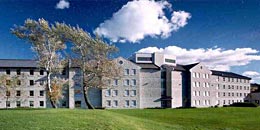
- Buildings
- Schools
 Manitoba: Collège Jeanne-Sauvé, Winnipeg
Manitoba: Collège Jeanne-Sauvé, Winnipeg Ontario: École publique Jeanne-Sauvé, Sudbury
Ontario: École publique Jeanne-Sauvé, Sudbury Ontario: Ecole Jeanne-Sauvé, Orléans
Ontario: Ecole Jeanne-Sauvé, Orléans Ontario: Jeanne Sauvé Catholic School, Stratford
Ontario: Jeanne Sauvé Catholic School, Stratford Ontario: Jeanne Sauvé French Immersion Public School, London
Ontario: Jeanne Sauvé French Immersion Public School, London Ontario: Jeanne Sauvé French Immersion Public School, St. Catharines
Ontario: Jeanne Sauvé French Immersion Public School, St. Catharines Ontario: Jeanne Sauvé French Immersion Public School, Oshawa
Ontario: Jeanne Sauvé French Immersion Public School, Oshawa
- Organizations
- Events
 Quebec: Jeanne Sauvé Lecture Series
Quebec: Jeanne Sauvé Lecture Series
Coat of Arms
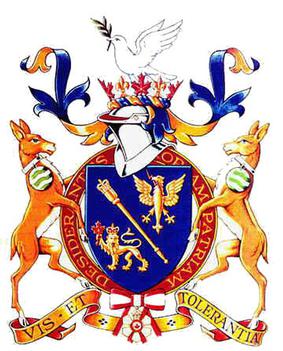 |
|
Images for kids
See also
 In Spanish: Jeanne Sauvé para niños
In Spanish: Jeanne Sauvé para niños


